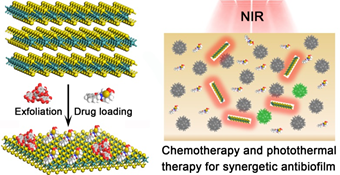Prof. Zhi-Kang Xu, Jian Ji and Ke Yao published research on ACS nano
Transition metal dichalcogenide (TMD) nanosheets have evoked enormous research enthusiasm and have shown increased potentials in the biomedical field. However, a great challenge lies in high-throughput, large-scale, and eco-friendly preparation of TMD nanosheet dispersions with high quality. Herein, we report a universal polyphenol-assisted strategy to facilely exfoliate various TMDs into monolayer or few-layer nanosheets. By optimizing the exfoliation condition of molybdenum disulfide (MoS2), the yield and concentration of as-exfoliated nanosheets are up to 60.5% and 1.21 mg/mL, respectively. This is the most efficient aqueous exfoliation method at present and is versatile for the choices of polyphenols and TMD nanomaterials. The as-exfoliated MoS2 nanosheets possess superior biomedical stability as nanocarriers to load antibiotic drugs. They show a high photothermal conversion effect and thus induce a synergetic effect of chemotherapy and photothermal therapy to harvest enhanced antibiofilm activity under near-infrared (NIR) light. All these results offer an appealing strategy toward the synthesis and application of ultrathin TMD nanosheets, with great implications for their development.

.png)